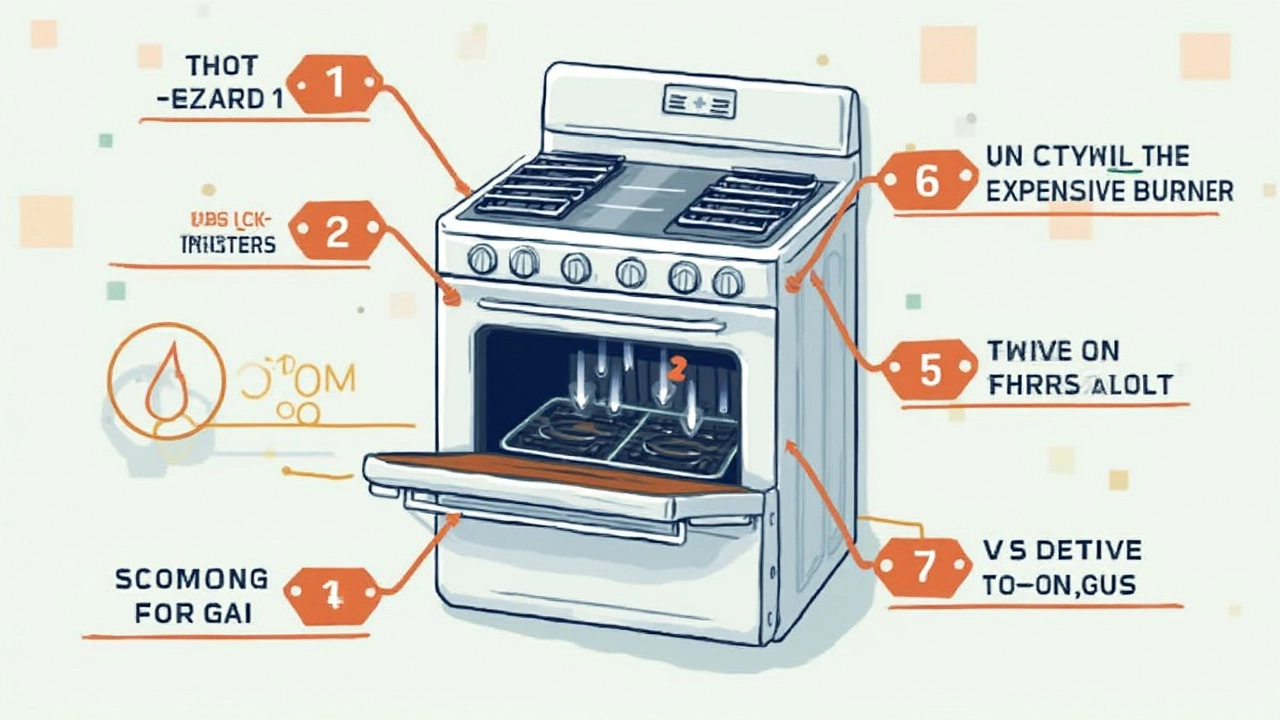No one plans for their gas oven to quit right when you’re about to host a dinner. But here you are: oven on the fritz, food plans ruined, and the big question spinning in your head—should you cough up the cash to fix it, or is it throwing good money after bad?
Money talk first because that’s what usually matters most. Most gas oven repairs land between $150 and $350. Something simple like a broken igniter or faulty thermostat? Those are on the cheap end. But when the problem goes deeper—think control board blown, gas valve shot, or major leaks—the cost jumps fast. Sometimes a repair bill sneaks right up to the price of a new basic oven.
Before you reach for the toolbox or dial a repair tech, it’s smart to know what you’re likely dealing with. That way you don’t waste time (or cash) chasing a fix that won’t stick. Got an oven that won’t heat, keeps shutting itself off, or leaks gas? Each problem points to something different under the hood, and some fixes really aren’t worth the hassle or risk.
- Common Gas Oven Problems and Costs
- Quick Fixes vs. Deal Breakers
- When Repair Makes Sense
- When to Replace Instead
- Practical Tips for Getting the Best Outcome
Common Gas Oven Problems and Costs
Gas ovens don’t usually die out of the blue. Most of the time, you’ll see signs: food not cooking evenly, weird smells, or burners that take ages to light. Let’s go straight to what usually busts first and break down what each fix might cost you.
- Igniter failure: The oven won’t heat up, or it takes forever. This is hands-down the biggest pain for owners. A new igniter runs about $20-$50 if you’re buying the part yourself, but with labor, expect a repair bill of $150-$300.
- Thermostat problems: If stuff comes out burnt or half-raw, your thermostat could be toast. New ones cost $40-$100. Add labor and you might be looking at the $180-$300 range.
- Faulty gas valve: If you smell gas even when the oven isn’t on, this is serious. A pro swap runs from $200-$350 on average, parts and labor together.
- Control board issues: When the oven ignores your commands, the board’s probably shot. Replacement parts can cost $150 to $300, with the total repair sometimes climbing over $400. At that point, you’re dangerously close to the price of a budget oven.
- Gas leaks: Don’t mess around. If there’s a gas leak, shut off the supply and call a pro. Repair costs wildly vary, but even small leaks fixed alongside another repair usually push your bill to the high end of the range.
One thing a lot of folks don’t realize: just cleaning up clogged burners and replacing old oven gaskets can fix small issues for under $50, sometimes with no tools needed. But, throw in a couple of bigger problems—especially anything involving gas supply—and costs add up quick. That’s why knowing exactly what’s gone wrong under the hood is so important before you commit to any fix.
Quick Fixes vs. Deal Breakers
Some gas oven problems are a breeze and won’t leave your wallet empty. Think of things like a burner that won’t spark or a pilot light that keeps going out. Often, it’s just a dirty igniter or a worn-out sensor—these parts are cheap and swapping them out usually takes less than an hour for a pro. You can even try it yourself if you’re comfortable turning off the gas and following a how-to video closely.
Then you’ve got the headaches—the problems that scream “ditch it.” If the gas valve itself fails or the oven leaks gas, that’s not just pricey, it’s risky. Board replacements or fixing recurring electrical failures usually makes sense only if your oven isn’t too old or still under warranty. Here’s where the age of your oven matters: most models last about 13 years. So if yours is pushing that mark, putting money into expensive repairs rarely works out.
- Gas oven repair (like igniter or sensor): Safe to DIY if you feel confident. Parts cost around $25–$75. Labor, if you hire out, is another $75–$150.
- Thermostat replacement: DIYers can sometimes handle it. Part is about $80. Labor can hit $100–$175.
- Control board or valve replacement: Usually $200 or more just for parts, plus labor. Here, repairs can get close to what a new oven costs.
Let’s break down how these costs stack up:
| Problem | Average Part Cost | Average Labor | Good DIY Candidate? |
|---|---|---|---|
| Igniter | $30–$70 | $75–$100 | Yes |
| Temperature Sensor | $25–$60 | $75–$130 | Yes |
| Thermostat | $80–$150 | $100–$175 | Maybe |
| Control Board | $150–$350 | $100–$180 | No |
| Gas Valve | $120–$240 | $130–$200 | No |
If your repair is a quick fix and doesn’t cost much, don’t hesitate—get it done and stretch your oven’s life a bit more. But if you’re looking at high parts costs, major labor, or anything related to gas leaks, play it safe and consider whether replacing is just smarter.

When Repair Makes Sense
So, when does it actually make sense to fix that stubborn oven sitting in your kitchen? Here’s the good news: a lot of gas oven issues are fixable without burning a hole in your wallet. If your oven is less than ten years old and hasn’t had a ton of problems before, a repair is usually the smart move. Most manufacturers say gas ovens can easily last 13 to 15 years if you take care of them.
The most common repairs, like swapping out an igniter, replacing a thermostat, or cleaning up a clogged burner, tend to be straightforward and hit the lower end of the cost range—usually $150 or even less if you’re hands-on. If your oven still has warranty coverage, you might even get a free fix or just pay for parts.
Another green light for repair: when the rest of the oven is in good shape. No rust, no weird smells, nothing falling apart? Then it’s just a single problem standing in your way. Also, if all your other kitchen appliances are working fine and the oven fits the space perfectly, fixing instead of replacing saves you the headache of hunting down a new model that works with your cabinets and gas line.
Ask yourself a few questions:
- Is the gas oven repair cost less than half of what a new oven would be?
- Has the oven been reliable up until now?
- Am I dealing with a simple, known issue (like a bad igniter or loose wire)?
- Do I feel safe having this oven repaired, or are there weird gas smells or unexplained noises?
If you’re nodding along to these points, fixing the oven just makes sense. You save money, avoid needless waste, and keep your kitchen routine smooth. If in doubt, getting a repair tech to give you a no-nonsense quote can help you decide fast. Reputable shops usually charge under $100 for a diagnostic visit, which can be worth it for the peace of mind alone.
When to Replace Instead
Sometimes you’re better off just swapping out your gas oven rather than spending cash trying to fix it. The rule of thumb most appliance pros use? If repairing costs more than half of what a new oven would set you back, think hard before grabbing your wallet. Right now in 2025, a bare-bones gas oven usually starts around $600, with fancier models hitting well over $1,200. So if your repair is anywhere near $300 or more, start checking your options.
Age matters, too. Most gas ovens last about 13 to 15 years with normal use. If you’re nursing one that’s over 10 years old and it needs a big fix, there’s a good chance more problems will pop up soon after you pay for that first repair. Pouring money into an aging appliance often leads to more headaches and “repair roulette.”
Some parts, like the heat exchanger or control board, cost so much to replace (upwards of $400 with labor) that it just doesn’t add up. Plus, brands stop making parts after a while. If your oven is an older or off-brand model, and you find out parts are discontinued or backordered for months, it’s not worth chasing last-ditch fixes.
- Your oven smells like gas even when it’s turned off, or there are visible cracks in the gas lines—this is a safety red flag. Don’t even think about repairs; replace it now.
- The inside lining is rusted through, or you spot heavy corrosion—no repair can fix that safely or for long.
- Performance still stinks after repairs—if your cookies keep burning on one side, or the heat never seems right, sometimes the oven’s just too worn out.
Energy costs count, too. Newer ovens are a lot more efficient. Running an old gas hog might cost you more on the monthly bill, so replacing can actually save you money over time. Only hang onto that old oven if repairs are cheap, parts are easy to get, and you love how it cooks. Otherwise, moving on is usually the smart move for your wallet and your sanity.
Remember, with anything gas oven repair, safety always trumps nostalgia. If you ever feel unsure, trust your gut (and your nose)—it's usually right.

Practical Tips for Getting the Best Outcome
Want to make the smartest move with your gas oven repair? You don’t have to be a pro, but a bit of strategy can save you both cash and stress. Here’s what I’ve learned (and what’s saved me from a few disasters).
- Pinpoint the real problem first. Don’t just guess. If your oven won’t heat, check if the igniter glows. If it does, but nothing happens, it’s probably the igniter. If you hear clicking but don’t smell gas, could be a clogged burner.
- Always check the oven’s age. If it’s past eight years old, be cautious. A 2024 survey by the Association of Home Appliance Manufacturers found most gas ovens start needing frequent repairs after year eight.
- Compare repair costs to replacement value. If the repair’s half (or more) the price of a new, similar model, it’s often better to buy new. Don’t let sentimental value trap you into wasting money!
- Ask about parts warranty and labor. Some repairs include 30- to 90-day warranties. Don't pay for a quick fix that fails next month.
- Think about safety. Leaks, weird smells, or anything involving gas lines are a hard stop for DIY. Call a certified tech if you spot those red flags.
- Don’t forget to check for recalls before you fix anything. Sometimes your oven model is part of a safety recall. If so, you could get parts or replacement for free.
- Get a written estimate before green-lighting any work. This gives you leverage if costs balloon mid-fix.
Here’s a quick breakdown of average repair costs so you know what to expect:
| Repair Type | Average Cost (USD) |
|---|---|
| Igniter replacement | $120–$250 |
| Thermostat fix | $150–$200 |
| Oven control board | $200–$400 |
| Gas valve repair | $300–$600 |
If you’re all thumbs like me, don’t try to be a hero. Even the most confident DIYers get stumped by old gas stoves. And believe me, gas leaks are no joke. Always smell for gas after you fix or move the oven—better safe than sorry.
One extra tip: ask your technician for the old part after repair. Sounds strange, but it keeps them honest. If they can’t show you the busted igniter or valve, question the work.
Bottom line? When it comes to gas oven repair, a little homework and safety focus go a long way. You’ll save yourself cash, worry, and maybe even a dinner.


